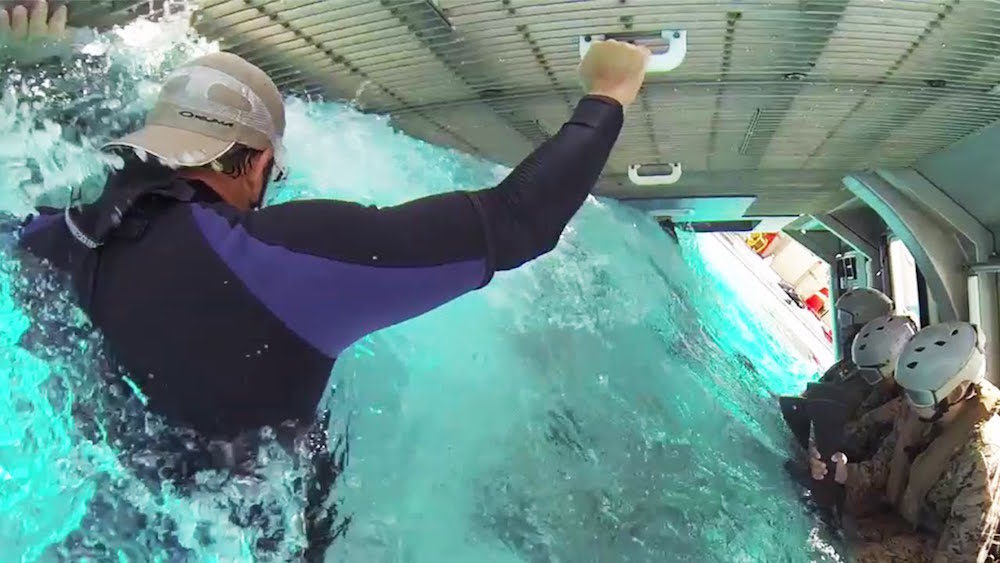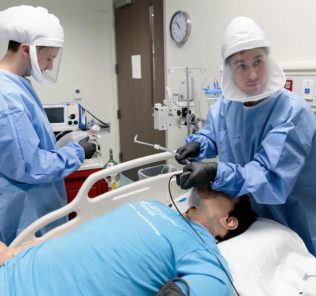U.S. Military Uses Underwater Helicopter Simulator To Save Marine Lives
The U.S. Military does not need convincing that simulation is a crucial part of training, necessary to save lives. Just look at the lengths the Marines go to provide new recruits with helicopter underwater crash training with this specialized Egress trainer. The device can provide for a multitude of training opportunities, with the key function enabling Marines to simulated crashing and flipping underwater in a helicopter in real time. Whatever the cost of this highly specialized training that will certainly occur rarely, the U.S. military knows every possible outcome must be trained for to preserve the lives of those who put themselves in harms way throughout their tours of duty. With the video below, you can watched how recruits of the 24th Marine Expeditionary Unit learn how to escape from a submerged aircraft while training at the Helicopter Underwater Egress Trainer aboard Camp Lejeune in Jacksonville, North Carolina.
This is certainly one of the more brutal and most demanding drills for special operations forces. The special purpose unit of US Marine Corps, 24th Marine Expeditionary Unit is trained to work in all environments, which includes underwater through this complicated and abnormal stress test. The drill itself checks their level of fitness and mental readiness to act under brutal conditions while practicing how to safely leave the helicopter that landed in the water. The Marines are seated tight and blindfolded!
Sponsored Content:
The Marines use a simulated helicopter body while training for different underwater escape scenarios as a qualification to be attached to a Marine Expeditionary Unit. “There are three stages to the exercise,” said Pfc. Connor Bunch, a helicopter mechanic with the unit. “We had classroom training, Shallow Water Egress Training, and the [Modular Amphibious Egress Trainer] in the deep end.”
The classes covered basic water safety, use of the equipment, and hands-on training and emergency procedures since it was the first time many of these Marines conducted the Modular Amphibious Egress Trainer and SWET. The SWET is a small, enclosed, chair with buoys that represents a cockpit of an aircraft. It flips Marines upside down in the water, allowing them to practice escaping by pushing through a side window of a sunken aircraft.
After Marines showed proficiency in the shallow water training, they advanced to the deep end of the pool. The MAET seats several Marines and sinks them into the water as it turns them upside down. There are three drops that each Marine had to pass while participating in MAET. Marines are tasked with escaping the submerged simulator off the air in their last breath, they have to drop all their gear before escaping and lastly they need to use an oxygen tank while exiting the craft.
Classroom Theory Applications
Sponsored Content:
- Pre-Flight Familiarization
- Helicopter Safety Equipment
- Helicopter Emergencies Procedures
- Brace for impact positions
- Helicopter underwater escape
- Operation of helicopter exits
- Rescue – Surface to surface, Surface to air (hoisting)
- Installation evacuation: types of emergencies, alarms, escape routes, muster locations, PPE
- Abandonment Options: helicopter, support vessel, lifeboats, liferafts, water entry
- Cold Water Philosophy: effects of cold water immersion, hypothermia, cold shock
- In Water Survival: PFDs, etc.
Practical Exercises
- Helicopter dry evacuation – land
- Passenger muster, boarding, launch, and disembarkation of survival craft
- Controlled ditch into aviation liferaft
- Helicopter Underwater Egress
- Surviving with F.A.A. Approved equipment:donning inflatable lifejacket, Lifejacket inflation
- Surviving without equipment: clothing inflation, use of floating debris
- Aviation life-raft – righting, boarding, features and supplies
- Helicopter Rescue: rescue strop, rescue jacket
- Surviving with USCG approved equipment: donning lifejacket
- Entry from a height
- Individual and group sea survival techniques- HELP, Huddle, towing, survival chain, circle, etc.
- Marine life-raft – righting, boarding, features and supplies
Each drop is unique for everyone because the situation and seat order changed in the simulator to enhance the realism of this training. “With all that happening at once, Marines can be disoriented and that creates fear,” said Bobby Pitchford, the site manager at the Water Survival Training Facility. “This training is meant to give them confidence in their abilities and their equipment.”
Marines endure this stressful training to give them the skills and mindset to safely exit from a sinking aircraft. “The reason we start in the classroom and move up to the dunker is to build confidence so they don’t just panic when they are flipped upside down in the water,” said Pitchford. “The craft and gear can easily be replaced, but lives can’t.”
Next, Learn Why the U.S. Navy Trusts
Simulation So Much That They Built Their Own Ocean!
Lance Baily, BA, EMT-B, is the Founder / CEO of HealthySimulation.com, which he started in 2010 while serving as the Director of the Nevada System of Higher Education’s Clinical Simulation Center of Las Vegas. Lance also founded SimGHOSTS.org, the world’s only non-profit organization dedicated to supporting professionals operating healthcare simulation technologies. His co-edited Book: “Comprehensive Healthcare Simulation: Operations, Technology, and Innovative Practice” is cited as a key source for professional certification in the industry. Lance’s background also includes serving as a Simulation Technology Specialist for the LA Community College District, EMS fire fighting, Hollywood movie production, rescue diving, and global travel. He and his wife live with their two brilliant daughters and one crazy dachshund in Las Vegas, Nevada.
Sponsored Content:


















